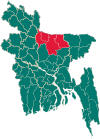Atpara Upazila
Atpara Upazila
আটপাড়া উপজেলা | |
|---|---|
 Madrassa in Atpara upazila | |
 | |
| Country | |
| Division | Mymensingh |
| District | Netrokona |
| Atpara Thana | 1926 |
| Atpara Upazila | 2 July 1983 |
| Government | |
| • Upazila Chairman | Muhammad Khairul Islam Sripuri |
| • MP (Netrokona-3) | Ashim Kumar Ukil |
| Area | |
• Upazila | 195 km2 (75 sq mi) |
| • Metro | 9.04 km2 (3.49 sq mi) |
| Population | |
• Upazila | 144,855 |
| • Density | 740/km2 (1,900/sq mi) |
| Time zone | UTC+6 (BST) |
| Postal code | 2470[2] |
| Website | atpara |
Atpara (Bengali: আটপাড়া) is the smallest upazila of Netrokona District, in the Division of Mymensingh, Bangladesh.[3]
History
[edit]When the Baro-Bhuiyans were in power in Bengal, Atpara was a part of the Sarkar Bazuhar. It later became part of the parganas of Sirujial and Mymensingh. The zamindar (landlord) of Mymensingh Pargana, Brajendra Kishore Roy Chowdhury of Gouripur named this area as Brajer Bazaar (Braj's market) after himself. It was later renamed to Atpara, although some locals may still refer to it today as Brajer Bazaar.[4]
During the Mughal period, a three-domed mosque was constructed in between the villages of Shormushia and Haripur. An established Hindu zamindar family later formed in the village of Rameshwarpur. The remnants of the family palace (Roy Bari) remains a popular tourist site.
The Village of Amati in Teligati Union, Atpara is quite notable. Social reformers such as Sonafor Uddin, Muktul Husayn Khan, Shariat Khan, Anfar Uddin, Manfar Uddin and Jafar Uddin were born in Amati. During British period, Shyam Biswas, a Bengali Hindu zamindar, was noted to be very cruel and abusive towards the local inhabitants. He had certain regulations such as no one being allowed to pass his front yard wearing shoes or slippers. The social reformers organised people against this humiliation, rising against Biswas. Their revolution was soon followed in other parts of the district. Amati became a symbol of revolution against tyrant landlords.
On 21 August 1917, Atpara was made a thana. During the Bangladesh Liberation War, freedom fighters attacked the Atpara Thana on 19 August 1971. They killed a number of Razakars as well as the officer-in-charge of the thana, and they also looted arms and ammunition from the thana. On 7 October, a battle was fought leading to the death of three more Razakars. Atpara was made an upazila on 2 July 1983.[3]
Demographics
[edit]According to the 2011 Census of Bangladesh, Atpara Upazila had 31,437 households and a population of 144,624. 39,623 (27.40%) were under 10 years of age. Atpara has a literacy rate (age 7 and over) of 38.70%, compared to the national average of 51.8%, and a sex ratio of 1005 females per 1000 males. 9,687 (6.70%) lived in urban areas.[6][7]
As of the 1991 Bangladesh census, Atpara had a population of 120491. Males constituted 51.15% of the population, and females 48.85%. This Upazila's eighteen up population is 60858. Atpara has an average literacy rate of 24% (7+ years), and the national average of 32.4% literate.[8]
Administration
[edit]Atpara Thana was formed in 1926 and it was turned into an upazila on 2 July 1983.[3]
Atpara Upazila is divided into seven union parishads: Baniyajan, Duoj, Lunesshor, Shormushia, Shunoi, Sukhari, and Teligati. The union parishads are subdivided into 139 mauzas and 177 villages.[9]
Chairmen
[edit]| Number | Name | Term |
|---|---|---|
| 01 | Zahirul Islam Khan Maju | 1985 - 1990 |
| 02 | Abul Husayn Master | 1990 - 1991 |
| 03 | Muhammad Khairul Islam Sripuri | Present |
Notable people
[edit]- Nuruzzaman Nayan, Coach, Bangladesh National Football Team
- Khalekdad Chowdhury, author
- Abdul Khaleq, assassinated politician
See also
[edit]References
[edit]- ^ National Report (PDF). Population and Housing Census 2022. Vol. 1. Dhaka: Bangladesh Bureau of Statistics. November 2023. p. 401. ISBN 978-9844752016.
- ^ "Bangladesh Postal Code". Dhaka: Bangladesh Postal Department under the Department of Posts and Telecommunications of the Ministry of Posts, Telecommunications and Information Technology of the People's Republic of Bangladesh. 20 October 2024.
- ^ a b c Bivuti Ranjan Ray (2012). "Atpara Upazila". In Sirajul Islam; Miah, Sajahan; Khanam, Mahfuza; Ahmed, Sabbir (eds.). Banglapedia: the National Encyclopedia of Bangladesh (Online ed.). Dhaka, Bangladesh: Banglapedia Trust, Asiatic Society of Bangladesh. ISBN 984-32-0576-6. OCLC 52727562. OL 30677644M. Retrieved 11 January 2025.
- ^ এক নজরে আটপাড়া. Atpara Upazila (in Bengali). Archived from the original on 2020-12-11. Retrieved 2020-07-09.
- ^ Population and Housing Census 2022 - District Report: Netrokona (PDF). District Series. Dhaka: Bangladesh Bureau of Statistics. June 2024. ISBN 978-984-475-237-5.
- ^ "Community Tables: Netrokona district" (PDF). bbs.gov.bd. 2011.
- ^ "Bangladesh Population and Housing Census 2011 Zila Report – Netrokona" (PDF). bbs.gov.bd. Bangladesh Bureau of Statistics.
- ^ "Population Census Wing, BBS". Archived from the original on 2005-03-27. Retrieved November 10, 2006.
- ^ "District Statistics 2011: Netrokona" (PDF). Bangladesh Bureau of Statistics. Archived from the original (PDF) on 13 November 2014. Retrieved 14 July 2014.

